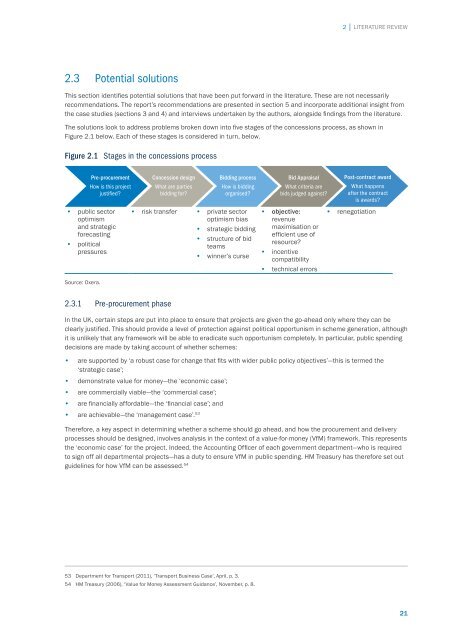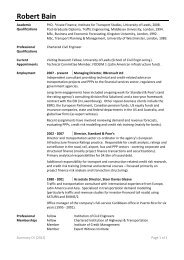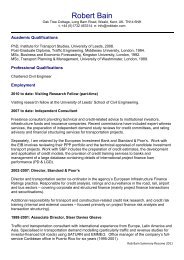Disincentivising overbidding for toll road concessions
Disincentivising overbidding for toll road concessions
Disincentivising overbidding for toll road concessions
- No tags were found...
You also want an ePaper? Increase the reach of your titles
YUMPU automatically turns print PDFs into web optimized ePapers that Google loves.
2 │ LITERATURE REVIEW<br />
2.3 Potential solutions<br />
This section identifies potential solutions that have been put <strong>for</strong>ward in the literature. These are not necessarily<br />
recommendations. The report’s recommendations are presented in section 5 and incorporate additional insight from<br />
the case studies (sections 3 and 4) and interviews undertaken by the authors, alongside findings from the literature.<br />
The solutions look to address problems broken down into five stages of the <strong>concessions</strong> process, as shown in<br />
Figure 2.1 below. Each of these stages is considered in turn, below.<br />
Figure 2.1 Stages in the <strong>concessions</strong> process<br />
Pre-procurement<br />
Concession design<br />
Bidding process<br />
Bid Appraisal<br />
Post-contract award<br />
How is this project<br />
justified<br />
What are parties<br />
bidding <strong>for</strong><br />
How is bidding<br />
organised<br />
What criteria are<br />
bids judged against<br />
What happens<br />
after the contract<br />
is awards<br />
••<br />
public sector<br />
optimism<br />
and strategic<br />
<strong>for</strong>ecasting<br />
••<br />
political<br />
pressures<br />
Source: Oxera.<br />
••<br />
risk transfer ••<br />
private sector<br />
optimism bias<br />
••<br />
strategic bidding<br />
••<br />
structure of bid<br />
teams<br />
••<br />
winner’s curse<br />
••<br />
objective:<br />
revenue<br />
maximisation or<br />
efficient use of<br />
resource<br />
••<br />
incentive<br />
compatibility<br />
••<br />
technical errors<br />
••<br />
renegotiation<br />
2.3.1 Pre-procurement phase<br />
In the UK, certain steps are put into place to ensure that projects are given the go-ahead only where they can be<br />
clearly justified. This should provide a level of protection against political opportunism in scheme generation, although<br />
it is unlikely that any framework will be able to eradicate such opportunism completely. In particular, public spending<br />
decisions are made by taking account of whether schemes:<br />
••<br />
are supported by ‘a robust case <strong>for</strong> change that fits with wider public policy objectives’—this is termed the<br />
‘strategic case’;<br />
••<br />
demonstrate value <strong>for</strong> money—the ‘economic case’;<br />
••<br />
are commercially viable—the ‘commercial case’;<br />
••<br />
are financially af<strong>for</strong>dable—the ‘financial case’; and<br />
••<br />
are achievable—the ‘management case’. 53<br />
There<strong>for</strong>e, a key aspect in determining whether a scheme should go ahead, and how the procurement and delivery<br />
processes should be designed, involves analysis in the context of a value-<strong>for</strong>-money (VfM) framework. This represents<br />
the ‘economic case’ <strong>for</strong> the project. Indeed, the Accounting Officer of each government department—who is required<br />
to sign off all departmental projects—has a duty to ensure VfM in public spending. HM Treasury has there<strong>for</strong>e set out<br />
guidelines <strong>for</strong> how VfM can be assessed. 54<br />
53 Department <strong>for</strong> Transport (2011), ‘Transport Business Case’, April, p. 3.<br />
54 HM Treasury (2006), ‘Value <strong>for</strong> Money Assessment Guidance’, November, p. 8.<br />
21






